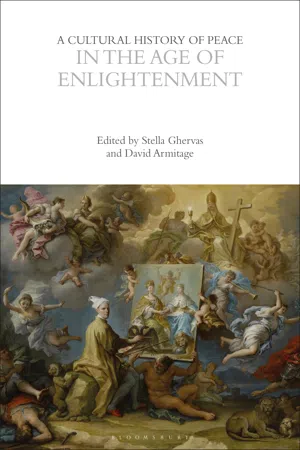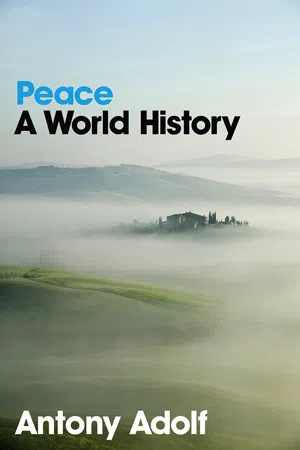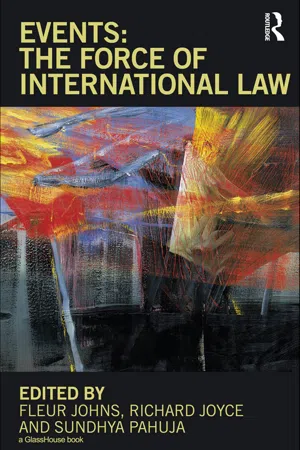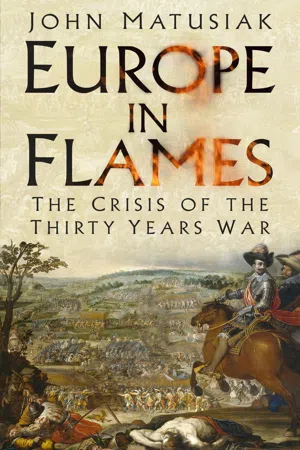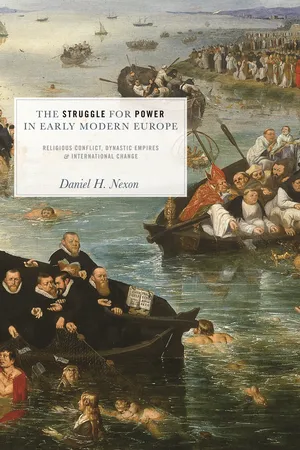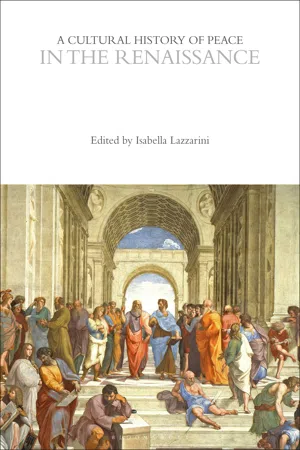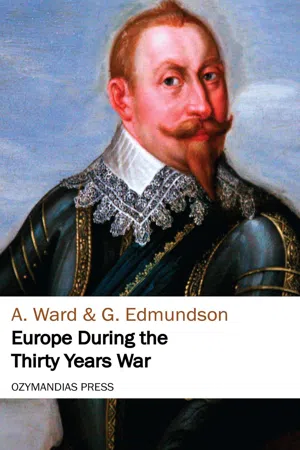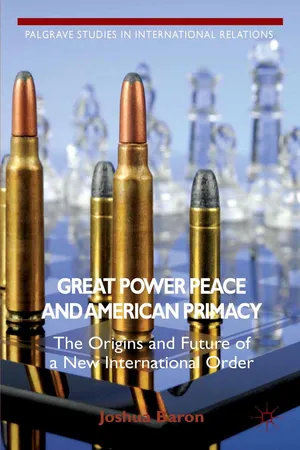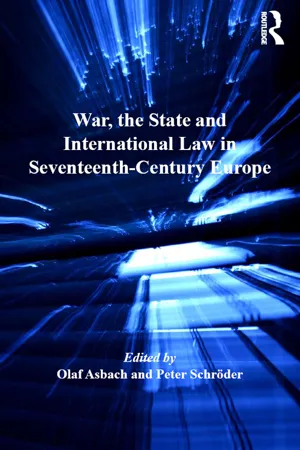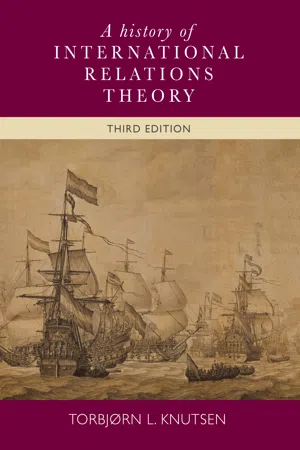History
Peace of Westphalia
The Peace of Westphalia, signed in 1648, marked the end of the Thirty Years' War in the Holy Roman Empire and the Eighty Years' War between Spain and the Dutch Republic. It is considered a landmark in the development of the modern state system, as it established the principle of state sovereignty and the idea of coexisting sovereign states in Europe.
Written by Perlego with AI-assistance
Related key terms
11 Key excerpts on "Peace of Westphalia"
- Stella Ghervas, David Armitage(Authors)
- 2022(Publication Date)
- Bloomsbury Academic(Publisher)
Such has long been, after all, a most basic and legal meaning of the term peace in European culture: as a treaty, a document putting an end to the state of war, and the resulting political state. “Peace,” in that restricted sense, was a condition beneficial to commerce and prosperity. It was alas transient, even though peace treaties were labeled as “perpetual” or “eternal,” seemingly as a countercharm. In the period under consideration, peace treaties thus appeared to the eyes of contemporaries as welcome pauses to disorders. For today’s historians, they serve as useful milestones for a meaningful chronology of peace (Arcidiacono 2011; Ghervas 2020a). 1648: THE END OF A CONVENTIONAL ORDER OF LATIN CHRISTIANITY? Let us now turn briefly to this “historical” Peace of Westphalia: it came as the result of a victory for German states in general and setbacks for the Austrian Habsburg dynasty in particular. It also brought relative stability to Germany and, by extension, to the lands west of it. The name of Westphalia derives from the name of the German state that hosted the negotiations and is a generalization, because the “peace” is really a series of treaties signed in 1648: Münster (30 January) between Spain and the Dutch Republics, and more importantly, Münster (24 October) between the Holy Roman Empire and France and allies, and Osnabrück (24 October) between the Holy Roman Empire and Sweden. To capture its essence, we can turn to Voltaire a century later: This Peace of Westphalia, finally signed in Münster and Osnabrück on 14 October 1648, was agreed, granted and received as a fundamental and perpetual law : these are the very terms of the treaty. It must serve as the basis for imperial capitulations [commitments made by a newly elected emperor]- tour de force for peace, identical treaties were signed in October and May, collectively referred to as the Peace of Westphalia. Cardinal Mazarin, chief advisor to the child “Sun King” Louis XIV of France, is generally considered the architect of the Peace. Borders reflecting actual spheres of influence were set, the Peace of Augsburg was reconfirmed with Calvinism as another option and the caveat that peoples could practice the Christianity of their choice regardless of their states’ religion, and heavy wartime trade restrictions were partially removed. But the Peace of Westphalia’s lasting results were political, for by it the intra-national principles of peace through state sovereignty, self-determination and non-intervention in internal affairs by other states were instituted and continue to be touted today. But one of the important questions the peacemakers of Westphalia did not address was how such principles would work to bring about peace within a nation-state. Political thinkers and activist before and after the Peace of Westphalia who have devoted themselves to this question have put forth answers as convincing as they are conflicting, and as influenced by their cultural circumstances as they have influenced those since.Among such prominent early modern polemicists was the Englishman Thomas Hobbes (1588–1679), upon whom the English Civil War had a profound effect. The son of a vicar, he graduated from Oxford and worked as a tutor to higher-born children, including the future King Charles II, translated Greek classics and wrote scientific, philosophical and political treaties. He accompanied his students on “grand tours” of the continent, during which he earned the respect of luminaries like René Descartes. Back in England, a split had occurred between Parliament and King Charles I over his abuses of power, including declaring wars and levying taxes to fund them without Parliament’s consent. Before civil war broke out, Hobbes, whose political writings already showed strong monarchical tendencies, fled to Paris. As Cromwell’s forces defeated the Royalists, Hobbes was writing his best-known book, Leviathan
- eBook - ePub
- Fleur Johns, Richard Joyce, Sundhya Pahuja(Authors)
- 2010(Publication Date)
- Routledge-Cavendish(Publisher)
Westphalia Event, memory, myth Richard Joyce[T]he origin makes possible a field of knowledge whose function is to recover it, but always in a false recognition … The origin lies in a place of inevitable loss. (Foucault 1977: 143)Introduction
The Peace of Westphalia of 1648 is routinely cited as the ‘event’ which marks the emergence of the modern sovereign state. From this point on, so the story goes, states are freed from religious and imperial rule and now provide the basis for their own authority. In doing so, they ground the existence and authority of international law. This event thus looms large in the international legal memory as its foundational moment.However, the notion that the Peace marked a decisive break between medieval notions of political authority and the modern states system has been called into question. The debate is keenest in the field of international relations. For Stephen Krasner, the ‘widely held view among international relations theorists and international lawyers which sees Westphalia as a major, perhaps a decisive, break marking the transition from the medieval to the modern world’ – a world now divided into sovereign states – ‘is wrong’ (Krasner 1993: 235, 238). As Krasner points out, political entities with more or less exclusive control over defined territories existed well before the Peace, and medieval forms of political authority – including authority exercised by the Holy Roman Empire and the papacy – continued well after it (Krasner 1993; see also Beaulac 2004). Responding to this debunking of the conventional view, Daniel Philpott has attempted to ‘rescue’ the ‘prestige of Westphalia’ by once again establishing its place at ‘the origin of modern international relations’ through an ‘updated defense, more subtle and qualified than the conventional wisdom’ (Philpott 2001: 76–77). Philpott accommodates the existence of elements of sovereignty prior to Westphalia by characterizing it as ‘the consolidation, not the creation ex nihilo - eBook - ePub
Europe in Flames
The Crisis of the Thirty Years War
- John Matusiak(Author)
- 2018(Publication Date)
- The History Press(Publisher)
Along with the Treaty of Brömsebro and the earlier Treaty of Münster between Spain and the United Provinces, the two treaties of Münster and Osnabrück, agreed to in October 1648 and finally ratified by the respective governments in February 1649, certainly encompassed the issues underlying nearly every international crisis that had occurred in the first half of the seventeenth century. Indeed, what became known under its umbrella designation as the Peace of Westphalia constituted, in effect, a summary of the history of European conflict since the death of Philip II. But its very scope encapsulated not only its achievements, which were undeniable, but also its limitations. For while the old controversies which combined territorial and religious interests were forever settled and Gustavus Adolphus became, in effect, the last great European monarch to equate religion with power politics, the way was merely opened for a new type of international aggrandisement as the prospect of Habsburg hegemony vanished once and for all, only to be replaced in due course by the ambition of Louis XIV and the alternative prospect of domination by France. Hereafter, the impotence of both the Holy Roman Emperor and Imperial Diet would ensure that as the Habsburgs became preoccupied with their hereditary possessions in the east, so Germany would remain mostly weak and disunited, with the sole exception of those few territories, like Brandenburg, capable of establishing forceful and coherent states in their own right. And Germany’s weakness was, of course, France’s strength.In the shorter term, moreover, peace would prove patchy, and the disbandment of armies a long and cumbersome process, since many of the delegates at Münster and Osnabrück, weary from their labours in pursuit of a political settlement, were soon transferring nevertheless to Nuremberg, where a new conference assembled to supervise, among other post-war practicalities, the payment of the 200,000 soldiers still mobilised. Yet no agreement on a phased withdrawal was reached for a further eighteen months, and even after that, Brandenburg and Neuburg engaged in minor hostilities – dubbed the ‘Düsseldorf cow-war’ – over Jülich-Cleves, while Sweden and Brandenburg did not finally partition Pomerania until 1653. Outside Germany, furthermore, fighting between France and Spain would continue until the French project of stopping the ‘progress’ of Spain finally ended with the Treaty of the Pyrenees in 1659. Thereafter, wars for dynastic, commercial or colonial ends would be fought with no less ardour, and though the disregarded protests of the Pope regarding the Peace of Westphalia confirmed the end of the papacy as international power – a development that had actually been in progress since at least the death of Sixtus V in 1590 – newcomers like the United Provinces and eventually Brandenburg Prussia would not be long in taking their place as challengers to the status quo. Sweden, too, would complicate the politics of north-east Europe by its domination of the Baltic over the next fifty years. - eBook - ePub
Princeton Studies in International History and Politics
Religious Conflict, Dynastic Empires, and International Change
- Daniel H. Nexon(Author)
- 2009(Publication Date)
- Princeton University Press(Publisher)
Its importance might be compared to other major peace agreements, such as the Treaty of Utrecht (1713). Such treaties exercised a significant influence over subsequent developments in European political relations without necessarily amounting to a revolution in the basic texture of international politics. Westphalia, for example, provided a model for future treaties, reorganized the constitution of the empire, led to territorial readjustments, and recognized the independence, albeit in a highly specific form, of the Swiss Confederation. The Spanish, as part of a related agreement, finally accepted the sovereignty of the Dutch Republic. 40 Let me consider each of the major arguments advanced in favor of the Westphalian hypothesis. Proponents of this hypothesis correctly note that, after Westphalia, religion diminished in importance as a source of intra-European warfare. We find fewer obvious instances of inter-state conflict justified primarily on religious grounds after 1648 than during the reign of Philip II of Spain (1556–1598) or during the Thirty Years’ War (1608–1648). Yet religion played important roles in William of Orange’s invasion of England in 1688, his campaigns in Ireland, the various attempts at Jacobite restorations in Britain, and in the English struggles with France in the seventeenth and eighteenth centuries. 41 Many of the factors that produced this transformation, moreover, operated independently of Westphalia itself. If the war had ended in 1629 or 1635, religion might have continued to be a crucial issue in intra-German politics: the carnage and exhaustion much of Europe experienced—and Germany in particular—between 1635 and 1648 clearly turned many against the pursuit of confessional objectives through military conflict. But imagine that the Thirty Years’ War had ended on Habsburg terms - eBook - ePub
- Isabella Lazzarini(Author)
- 2022(Publication Date)
- Bloomsbury Academic(Publisher)
CHAPTER ONEDefinitions of Peace
FILIPPO DEL LUCCHESE AND ALASTAIR MORDAUNTThe period under our scrutiny is roughly delimited by two major treaties, the peace of Lodi in 1454 and the Peace of Westphalia in 1648. The two tumultuous centuries that separate these events fundamentally shape future philosophical ideas and the political paradigms that establish Western Europe as the crucible in which modernity is formed. Of critical political importance to this process is the rise of nation states, especially in Spain, France, and England, and the corresponding diminution of the respublica christiana, the name given to a combination of territorial Christian unity and the corresponding reach of Roman Catholicism.This paradigm shift in political organization creates new principles in the management of these emerging state’s affairs, both internally, within the increasingly well-defined borders, and in their external relations. As our period progresses, nation states become more autonomous from Rome and more dependant upon their own resources to make and enforce agreements among one another. Consequently, a more complex “balance of power” across larger geographical areas influences how and why wars are fought and peace treaties negotiated.In the early part of our period, the dream of Charles V and his heirs of a universal Hispanic-Habsburg Empire is undermined mainly by their confrontation with the Ottoman empire in the east, the French in Italy, and the rising Dutch commercial power in the North of Europe. In addition, from 1517, Christian unity in Germany starts to fracture due to the Protestant Reformation, the scope and reach of which is only restrained by a Catholic Counter-Reformation that in turn strengthens the national “sovereign” governments where Catholicism remains and thrives.Economic changes manifest themselves rapidly in this period. In a relatively short period after Columbus “discovers” America in 1492, the Europeans explore and open up extensive trade with the rest of the world, creating new colonial empires and unleashing new wealth that begins to generate nascent forms of capitalist economic activity. Within this triad of new economic interests, the invention of modern sovereignty, and the Protestant Reformation, we can distinguish two approaches to the problem of peace—one distinctly religious, and one distinctly political. - eBook - ePub
Cosmopolitanism
A Philosophy for Global Ethics
- Stan van Hooft(Author)
- 2014(Publication Date)
- Routledge(Publisher)
Accordingly, the Treaty of Westphalia needed to establish new bases for territorial boundaries and new definitions of the rights and responsibilities of temporal rulers in relation to other powers. It was agreed to define firm boundaries for states and to give a defined range of authority to the relevant ruler over the lands so bounded. This gave rise to the all-important concept of the “sovereignty of states”, giving to each state or kingdom the fundamental right of political self-determination. No prince or bishop had the right to impose his religious convictions on the prince or people of another state or to invade another state for any but a clearly defined set of reasons. Any non-military form of interference in the internal affairs of other states was also forbidden. From a legal point of view, all states were to be of equal standing to each other even if their actual military strength might differ. But if the power of temporal rulers to interfere in the affairs of other states was radically reduced, their powers over their own territories were greatly enhanced. People were now clearly defined as subjects of their princes with no overlapping or extraneous allegiance to any other power, be it an emperor or a bishop.Even though the Treaty of Westphalia established the system of nation-states that we recognize today, it did nothing to overcome the rivalry and competitiveness between states that had been the norm before its institution. It certainly did not introduce a new era of moral relations between states. It was the product of the exhaustion brought on by thirty years of destructive war in which the population of northwest Europe was thought to have been reduced by over a third. It was the product of a pragmatic wish to bring the destruction to an end. It sought to do this by ensuring a balance of power between states that could, either by force of arms or by alliances with better-armed states, stave off the predations of more powerful neighbours. It did not usher in a new era of harmony based on moral or religious consensus, but a new form of peace that was more like a truce between armed camps. The animosities did not die away but were merely contained by the division of Europe into nation-states with standing armies that kept their neighbours at bay.In the Westphalian system a state was not just a legal entity but also a power-based entity, so that a “real” state was one that could defend or expand its borders and be part of the balance of power that maintained stability in the international order. A would-be state that did not have such power (such as colonies or countries from which trade concessions could be forced without the traders being subject to local law) was regarded as fair game. The system of states was therefore unequal, with only the powerful effectively having full state rights. This is the situation described by theorists of international relations as “realism”. Such theorists argue that the situation between states today is not essentially different from that developed in the seventeenth century. - eBook - ePub
- A. Ward(Author)
- 2018(Publication Date)
- Ozymandias Press(Publisher)
France and Sweden would gladly have lessened the prestige of the House of Austria by introducing into the constitution of the Empire a provision that henceforth no election of a Roman King should be held during the lifetime of an Emperor. They were also desirous of augmenting the power of the Estates at large, among whom Sweden was now herself to be numbered; and France hoped to exercise an enduring influence, by making their assent requisite for the holding of any such election, and for the settlement of a permanent Wahlcapitulation limiting the Imperial authority. But the Austrian diplomacy succeeded in holding over the consideration of these matters for the next Diet. On the other hand the two Powers were able to delay the actual conclusion of the Peace for some time after its articles were complete by long discussions as to the proper ways of executing and of securing it. The Peace was actually signed at both Münster and Osnabrück on October 27, 1648; but, though the Emperor’s edicts for its execution were issued -a fortnight afterwards, the ratifications were not exchanged till February 8, 1649. Meanwhile the exchange of prisoners and other matters appertaining to the execution of the Treaties had been taken in hand by the military commanders, and were not wound up till June, 1650, at Nürnberg. The protest which the Papal Nuncio had offered against the Peace immediately after its conclusion, was reiterated a month later by Pope Innocent X in the Bull Zelo domus Dei (November 26, 1648); but its validity had been denied beforehand in the Peace itself, and no proceeding could have demonstrated more palpably the complete estrangement which now prevailed between the Imperial and the Papal authority. As a matter of fact, the Papal protest is not known to have been ever invoked by any Power against any stipulation of the Peace of Westphalia.Each of the two Powers, whose alliance had prolonged the War, might now seem to have achieved its ends. The statesmanship of Sweden, hardly less than the heroic deeds of her great King and a succession of eminent commanders, had obtained for her the position of a great European Power. But her losses in men were so serious, that a war on a similar scale could hardly be contemplated by the living or the next generation; while the monarchy could only defray the financial cost of the effort by processes which ended in changing the bases of Swedish constitutional life. The Swedish Crown had acquired a fair German province which provided the security desired by both Gustavus Adolphus and Oxenstierna for the kingdom itself and for the sufficiency of its share in the control of the Baltic. Sweden hereby also secured a permanent right to a participation in the affairs of the Empire, which might at any time be used for the purpose of once more gaining the control of them. But she had to reckon with the jealousy of her new neighbour Brandenburg as well as with old Scandinavian enmities; and the maintenance of the position which she at present held among the States of Europe could not be regarded as definitely assured. - eBook - ePub
Great Power Peace and American Primacy
The Origins and Future of a New International Order
- J. Baron(Author)
- 2014(Publication Date)
- Palgrave Macmillan(Publisher)
2. Learning to get along: The formalization of diplomacyThe norm of toleration could only go so far in minimizing the extent of warfare. It closed one critical path to fighting, but left open many others. While rulers were unwilling to let go of the use of violence to accomplish their political goals, they did have a desire to have ways of bringing conflicts to an end that were not serving those goals.We now take for granted that nations have formal means of communicating and negotiating with each other, but at the start of the modern era, “the machinery and institutions of international relations even in advanced countries” had barely progressed “beyond those of the Italian city-states system of the fourteenth century.”69 With the Peace of Westphalia, diplomacy began to take shape. In fact, the Westphalian congress initiated a roadmap of working together to resolve conflicts, as it “established new rules concerning the way diplomatic relations should be conducted. Arrangements which had previously been spasmodic, and had been interrupted recently by religious differences, were now regularised.”70The practices of diplomacy accelerated over the following decades. By around 1800, “the situation had greatly changed. Major powers now maintained permanent missions abroad, at least in the most important capitals, and standing foreign policy offices and apparatuses at home. The role and functions of diplomats had been clarified and immunity was established in principle, if still sometimes contested and violated in practice.”71 The Westphalian settlement conference was likewise repeated at numerous intervals. Since that time, “the diplomatic history of Europe has stridden along from one congress to another.”72The commitment to improving the nature of their relations did not come close to overcoming the struggle for position within the great power system, but it was an essential element of the effort to moderate conflict. Morgenthau describes the role of diplomacy as “often spectacular and brilliant and always important,” and ascribes its effective practice to be from “the end of the Thirty Years’ War to the beginning of the First World War.”73 - Olaf Asbach, Peter Schröder(Authors)
- 2016(Publication Date)
- Routledge(Publisher)
For the first time, legal standing was extended to the Reformed Protestant Church, Calvinism having been excluded from the 1555 settlement. Now princely and imperial signatories to the 1648 settlement would have to tolerate freedom of worship for three confessions within their territorial jurisdictions. In principle, there would be no return to enforced religious unity given this constraint upon a territorial prince’s capacity to exercise the jus reformandi. Importantly, if the Respublica christiana no longer ruled, treaties such as Westphalia became the very foundation of a law of nations conceived in Pufendorfian style. Yet if the terms of the Westphalian treaty were to be binding, it would have to be by virtue of the guarantee provided by French power. This was of course an act of national interest quite in keeping with France’s longstanding anti-imperial aims: resisting the Habsburgs’ Madrid-Vienna axis and neutralising the Catholic co-ordinates of the German Holy Roman Empire. Though anti-imperialism sat awkwardly with Pufendorf’s respect for the imperial public law, as a juristically-minded “Westphalian” he could nonetheless approve mid-century French power as a contribution to religious peace in Europe. Pufendorf's Post-1685 Perspective on France The situation was different after 1685. As the instrument of Catholic Bourbon power, France now posed the danger. Within two years of the revocation of the Edict of Nantes, Pufendorf published De habitu religionis christianae ad vitam civilem (Of the Nature and Qualification of Religion in Reference to Civil Society). De habitu is a resolutely anti-Catholic and anti-Louis XIV polemic dedicated to Friedrich-Wilhelm, Prince Elector of Brandenburg. The one sovereign was the current aggressor against Christ’s church, the other its potential defender- eBook - ePub
A history of International Relations theory
Third edition
- Torbjørn L. Knutsen(Author)
- 2016(Publication Date)
- Manchester University Press(Publisher)
The seventeenth century opened in the name of God. It evolved through conflicts and wars that were fuelled by incompatible religious interpretations. The century closed in the name of the absolute monarch and with the secular argument that war could be kept at bay through a policy of counterpoise. During the course of this process, International Relations theory came of age.This coming of age was indicated by a proliferation of books and treatises which discussed interstate relations. It was attended by a trend towards a more secularized view of political affairs. Social theorists increasingly saw the causes of war less as God’s intention to punish people for their sins, and more in terms of properties of human nature and of the interplay of human interests. Hobbes, Crucé, Spinoza and Grotius, for example, all explained the causes of war in terms of human emotions such as greed and pride; and they all found new hopes for a peaceful social order in people’s ability to calculate that human existence would be much improved if human reason could impose limits upon human passions. Also, all of them based their argument on a secular redefinition of the concept of ‘natural law’.This development is apparent in the works of Samuel Pufendorf (1632–94). He was keenly aware of the international changes which had occurred in his lifetime. He saw the Treaty of Westphalia (1648) as a watershed in international history, and distinguished sharply between the chaotic world of war and devastation which preceded Westphalia and the orderly world of self-governing equilibrium which emerged after it. He noted that, before Westphalia, authors like Grotius and Hobbes had been naturally predisposed by chaotic circumstances to ask how humans could establish an orderly society. And he realized that, once the Westphalian system of sovereign states was established, it was more natural to ask how one could ensure that sovereign actors would become useful contributors to an orderly Europe. To achieve this end, he argued, it was necessary to devise a new morality which could gain the consent of all Europeans. The essential constituents of this new morality, ‘which would teach one how to conduct oneself to become a useful member of human society, are called natural laws’ (Pufendorf 1991
Index pages curate the most relevant extracts from our library of academic textbooks. They’ve been created using an in-house natural language model (NLM), each adding context and meaning to key research topics.
